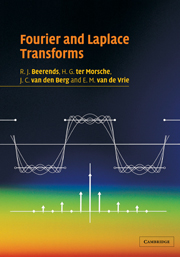Book contents
- Frontmatter
- Contents
- Preface
- Introduction
- Part 1 Applications and foundations
- Part 2 Fourier series
- Part 3 Fourier integrals and distributions
- 6 Fourier integrals: definition and properties
- 7 The fundamental theorem of the Fourier integral
- 8 Distributions
- 9 The Fourier transform of distributions
- 10 Applications of the Fourier integral
- Part 4 Laplace transforms
- Part 5 Discrete transforms
- Literature
- Tables of transforms and properties
- Index
6 - Fourier integrals: definition and properties
Published online by Cambridge University Press: 05 June 2012
- Frontmatter
- Contents
- Preface
- Introduction
- Part 1 Applications and foundations
- Part 2 Fourier series
- Part 3 Fourier integrals and distributions
- 6 Fourier integrals: definition and properties
- 7 The fundamental theorem of the Fourier integral
- 8 Distributions
- 9 The Fourier transform of distributions
- 10 Applications of the Fourier integral
- Part 4 Laplace transforms
- Part 5 Discrete transforms
- Literature
- Tables of transforms and properties
- Index
Summary
INTRODUCTION
We start this chapter with an intuitive derivation of the main result for Fourier integrals from the fundamental theorem of Fourier series. A mathematical rigorous treatment of the results obtained is postponed until chapter 7. In the present chapter the Fourier integral will thus play a minor role. First we will concentrate ourselves on the Fourier transform of a non-periodic function, which will be introduced in section 6.2, motivated by our intuitive derivation. After discussing the existence of the Fourier transform, a number of frequently used and often recurring examples are treated in section 6.3. In section 6.4 we prove some basic properties of Fourier transforms. Subsequently, the concept of a ‘rapidly decreasing function’ is discussed in section 6.5; in fact this is a preparation for the distribution theory of chapters 8 and 9. The chapter closes with the treatment of convolution and the convolution theorem for non-periodic functions.
LEARNING OBJECTIVES
After studying this chapter it is expected that you
- know the definition of the Fourier transform
- can calculate elementary Fourier transforms
- know and can apply the properties of the Fourier transform
- know the concept of rapidly decreasing function
- know the definition of convolution and know and can apply the convolution theorem.
An intuitive derivation
In the introduction we already mentioned that in order to make the basic formulas of the Fourier analysis of non-periodic function plausible, we use the theory of Fourier series.
- Type
- Chapter
- Information
- Fourier and Laplace Transforms , pp. 138 - 163Publisher: Cambridge University PressPrint publication year: 2003



